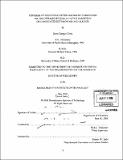| dc.contributor.advisor | Rick L. Danheiser. | en_US |
| dc.contributor.author | Horta, Javier Enrique | en_US |
| dc.contributor.other | Massachusetts Institute of Technology. Dept. of Chemistry. | en_US |
| dc.date.accessioned | 2008-02-28T16:27:52Z | |
| dc.date.available | 2008-02-28T16:27:52Z | |
| dc.date.copyright | 2006 | en_US |
| dc.date.issued | 2006 | en_US |
| dc.identifier.uri | http://dspace.mit.edu/handle/1721.1/36251 | en_US |
| dc.identifier.uri | http://hdl.handle.net/1721.1/36251 | |
| dc.description | Thesis (Ph. D.)--Massachusetts Institute of Technology, Dept. of Chemistry, 2006. | en_US |
| dc.description | Vita. | en_US |
| dc.description | Includes bibliographical references. | en_US |
| dc.description.abstract | This dissertation describes studies of the feasibility and scope of intramolecular [4+2] cycloadditions of hetarenynes and alkynes as a method for the synthesis of polycyclic benzo[b]-fused five-membered heteroaromatic compounds. Only scattered reports of this transformation existed prior to our work and these were very limited in their scope. The research presented in this thesis demonstrates that the synthesis of benzo[b]-fused five-membered heteroaromatic compounds can be effectively carried out under relatively mild thermal conditions utilizing alkynylpyrroles, -thiophenes, or -furans tethered to alkynes. The hetarenyne cycloaddition substrates are readily prepared in 2-3 steps from commercially available or known 2- or 3-halohetarenes via Sonogashira coupling followed in most cases by a Mitsunobu reaction. In the majority of cases metalation of a terminal alkyne with a Grignard reagent and then reaction with various electrophilic reagents allows for the creation of a library of cycloaddition substrates. The scope of the hetarenyne cycloaddition was explored with respect to four major variables in the cycloaddition substrates: | en_US |
| dc.description.abstract | (cont.) (1) the nature of activating groups attached to the alkynyl 2c component; (2) the composition of the tether connecting the 2n and 4 components; (3) the type of hetarene (i.e., pyrrole, thiophene, or furan); and (4) the position of attachment of the tether to the hetarene. The experimental findings can be summarized as follows: (1) electron-withdrawing and electronegative groups attached to the 2 component accelerate the cycloaddition; (2) electronegative heteroatoms within the tether accelerate the cycloaddition; (3) the order of reactivity of hetarenynes is: alkynyl-(N-Boc)pyrrole - alkynylfuran > alkynylthiophene; and (4) attachment of the tether bearing the 2c component at C-2 of the hetarene leads to a more facile reaction than attachment at C-3. Finally, the cycloaddition of substrates having Lewis basic substituents attached to the 27c component can be effectively promoted by the use of Lewis acids under very mild conditions, leading in most cases to an improved yield. | en_US |
| dc.description.statementofresponsibility | by Javier Enrique Horta. | en_US |
| dc.format.extent | 235 p. | en_US |
| dc.language.iso | eng | en_US |
| dc.publisher | Massachusetts Institute of Technology | en_US |
| dc.rights | M.I.T. theses are protected by copyright. They may be viewed from this source for any purpose, but reproduction or distribution in any format is prohibited without written permission. See provided URL for inquiries about permission. | en_US |
| dc.rights.uri | http://dspace.mit.edu/handle/1721.1/36251 | en_US |
| dc.rights.uri | http://dspace.mit.edu/handle/1721.1/7582 | |
| dc.subject | Chemistry. | en_US |
| dc.title | Synthesis of polycyclic heteroaromatic compounds via the intramolecular [4+2] cycloaddition of conjugated hetarenynes and alkynes | en_US |
| dc.type | Thesis | en_US |
| dc.description.degree | Ph.D. | en_US |
| dc.contributor.department | Massachusetts Institute of Technology. Department of Chemistry | |
| dc.identifier.oclc | 77275847 | en_US |
